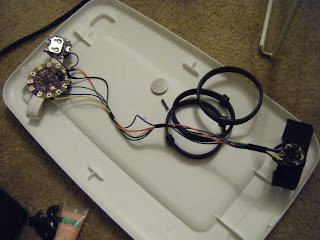http://lilypadarduino.org/?p=384
http://web.media.mit.edu/~leah/LilyPad/build/accelero_shirt.html
http://www.geeetech.com/wiki/index.php/LilyPad_Accelerometer_ADXL335
Due to the issues regarding the use of the conductive thread, I decided to make wearables with jewelry and the jumper wires instead of the thread and hoodie.
I had a metal bracelet lying around, so I took some black felt and super-glued it to the outside of the band to keep the circuits from touching it and shorting out.
Then I attached the wires to the accelerometer before super-gluing it to the felt. It took a couple tries because the felt kept soaking up the glue.
I really liked how the colors looked coming from it, much better than the boring metallic gray of the conductive thread, almost liked veins. I think itis much happier, more whimsical looking, which is good because I want this to be something you want to wear. Something you'd be willing to playfully interact with.
I wanted to attach the Lilypad main board to my arm, but I did not have any jewelry cuffs that would fit my biceps. So I used some elastic bands, which I would like to replace with an actual cuff in the final.
The three leds lightup differently depending on the movement of my arm, and the accelerometer.
So here's the code I used.
// the setup routine runs once when you press reset:
void setup() {
// initialize serial communication at 9600 bits per second:
Serial.begin(9600);
pinMode(11, OUTPUT);
pinMode(10, OUTPUT);
pinMode(9, OUTPUT);
digitalWrite(11, LOW);
digitalWrite(10, LOW);
digitalWrite(9, LOW);
}
// the loop routine runs over and over again forever:
void loop() {
// read the input on analog pin 0:
int xValue = analogRead(A3);
delay(1);
int yValue = analogRead(A4);
delay(1);
int zValue = analogRead(A5);
// print out the value you read:
Serial.print("X value is: ");
Serial.println(xValue);
Serial.print("Y value is: ");
Serial.println(yValue);
Serial.print("Z value is: ");
Serial.println(zValue);
Serial.println(" "); // Makes a space between the readings
//making leds glow
float mappedx = map(xValue, 230, 390, 0, 255 );
float mappedy = map(yValue, 230, 390, 0, 255 );
float mappedz = map(zValue, 230, 390, 0, 255 );
analogWrite(11, mappedx);
analogWrite(10, mappedy);
analogWrite(9, mappedz);
delay(1000);
}









No comments:
Post a Comment